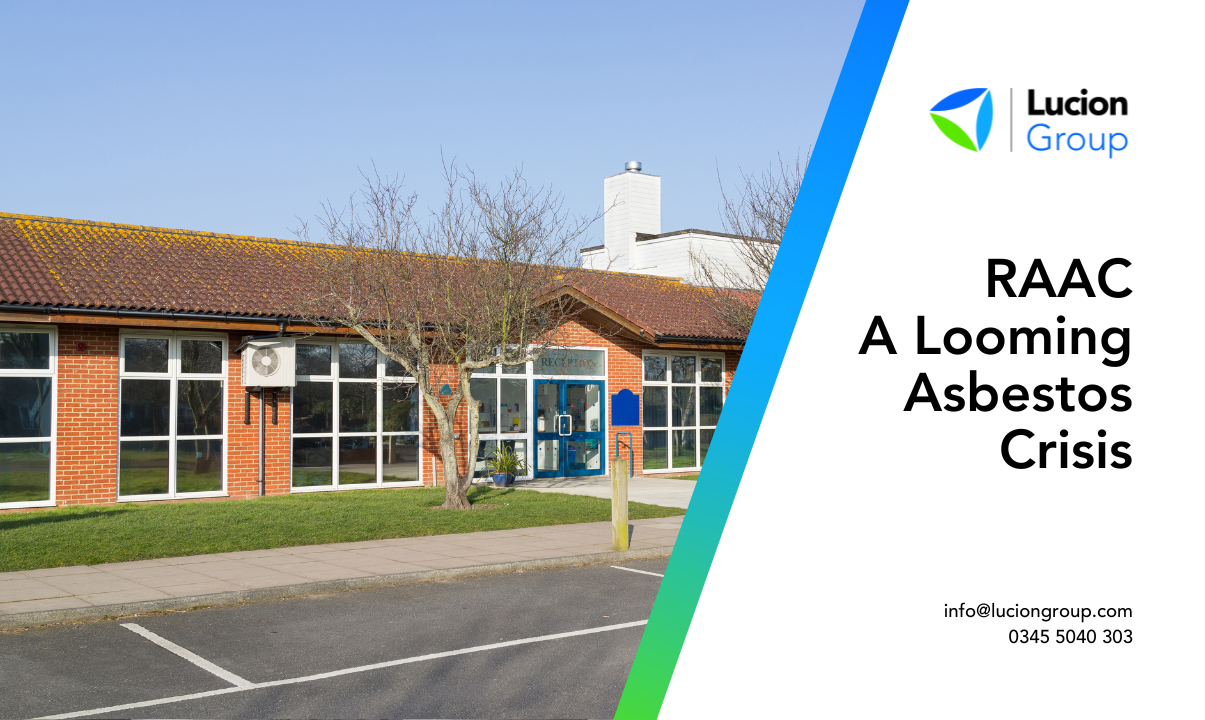RAAC: A Looming Asbestos Crisis in UK Buildings
7 September 2023
Predominantly used from the 1950s to the 1990s RAAC was considered a cost-effective alternative to traditional concrete, offering faster production and easier installation. However, despite its initial appeal, Reinforced Autoclaved Aerated Concrete (RAAC) exhibits lower durability compared to conventional concrete, typically lasting around 30 years. What makes RAAC particularly worrisome is its susceptibility to structural failure when exposed to moisture due to its porous nature, which permits water infiltration and can lead to the corrosion and weakening of any reinforcing bar (rebar) within the material.
In late August the Government ordered over 100 schools in England to close due to RAAC safety fears. Whilst schools scramble to try and find alternative accommodation for students entering the new academic year and look to have works to rectify the RAAC issue, concerns around asbestos disturbances in these public buildings have come to light.
Following the Government’s announcement, Lucion’s QHSE Director Chris Parr provides insight into RAAC and the related asbestos issue.
RAAC: A Lightweight, Short-Lived Alternative
Reinforced Autoclaved Aerated Concrete or ‘RAAC’, is often likened to the texture of an Aero chocolate bar - an aerated concrete variant that served multiple purposes in construction, including flat roofing, floors, and walls.
According to the Standing Committee on Structural Safety (SCOSS), there are unequivocal, significant differences between RAAC and traditional concrete. With tens of thousands of structural panels already in use, with many showing signs of wear and deterioration, the Health and Safety Executive (HSE) has stated that RAAC has exceeded its expected lifespan and may "collapse with little or no notice."
Reports also indicate that short-term exposure to moisture reduces RAAC's strength by approximately 13%, while long-term exposure to "polluted air" can reduce it by a staggering 40%. Safety concerns related to ageing RAAC first surfaced in the 1980s and 1990s when roof collapses led to building demolitions. In 1996, a government-funded report from the Building Research Establishment (BRE) found RAAC panels cracking in housing developments and noted cracks and bends in panels installed in schools. Though no immediate safety risks were identified, the report recommended annual inspections for RAAC panels in visually poor condition and inspections every five years for those in good condition.
Due to the aforementioned vulnerabilities, RAAC is often coated with other materials like bitumen, especially on roofing panels. Unfortunately, these protective coatings can degrade over time, further compromising the integrity of the material.
The Institute of Structural Engineers report, ‘Reinforced Autoclaved Aerated Concrete (RAAC) Panels Investigation and Assessment’, states;
“Assessments of buildings with RAAC panels are recommended to include a balance of risks for the continued use of the building against the benefit of strengthening or replacement of the panels.”
As schools appoint structural engineers to assess the issue, the crisis surrounding RAAC's structural integrity may be the tip of the iceberg, unearthing a far-reaching problem: asbestos in public buildings.
Asbestos and RAAC
The period from the 1950s to the 1990s, which coincided with RAAC's use, also marked the peak of asbestos use in construction before its eventual ban due to severe health risks posed by inhalation.
This connection raises a grim possibility. As crumbling RAAC is dealt with in public buildings, asbestos lurking in the same structures could be exposed and will likely need to be removed before the full extent of the concrete’s condition can be assessed. Asbestos, banned more than two decades ago, still lingers in at least 300,000 non-domestic buildings in the UK.
The Health and Safety Executive’s (HSE) report, Management of Asbestos in School Buildings 2022/23, released at the start of July 2023 indicated several improvement areas for schools managing their asbestos risks.
Some of the common issues identified and recommended areas for improvement included:
- A lack of documentation and process:
- Many asbestos surveys didn’t clearly show the location of asbestos. Asbestos registers did not indicate completed remedial actions. There was a lack of clear and understandable asbestos management plans, infrequent monitoring of ACMs, and inadequate incident procedures.
- Schools needed to ensure that staff had clear roles and responsibilities for managing asbestos and that contingency plans were in place to cover staff absences.
- Schools should ensure that contractors tendering for work provide risk assessments, method statements, and evidence of asbestos awareness training.
The re-emergence of asbestos-related concerns and lack of asbestos documentation in the midst of the RAAC crisis could slow down remediation efforts and extend school building closures by months, presenting a formidable challenge for the government.
Given the diverse range of construction ages and building types in the education sector, including the various Consortium of Local Authorities Special Programme (CLASP) buildings still in use, each premise needs individual assessment, considering factors such as its age and construction type.
Beyond Schools
The dangers of RAAC have brought to light not only structural vulnerabilities but also the potential revival of asbestos-related risk. Whilst this issue has been highlighted in school, the issue of RAAC and asbestos extends to all public buildings including NHS hospitals.
As the UK grapples with the consequences of using RAAC in its public buildings, a comprehensive strategy for addressing both the immediate and long-term risks is imperative to safeguard public safety and prevent a crisis of unparalleled proportions.
Lucion is supporting any schools affected by RAAC. With decades of experience in the Education Sector, we successfully partner with schools and higher education clients throughout the UK, providing asbestos management and ongoing compliance.
Our team have worked with over 60 individual local authorities in the last 2 years, independent schools and higher education facilities, who have seen the benefits of engaging a UKAS-accredited company and the UK’s market leader in asbestos management.
Utilising the advanced technology unique to Lucion, working practices that our clients typically require in this sector, the flexibility to work outside normal working hours and the ability to respond efficiently to emergency situations, such as RAAC-related closures, makes us the perfect partner in your journey to a safer environment for your staff and pupils.
In addition, to safeguard those who use your properties, everyone who works for Lucion is DBS checked every 2 years, in smart liveried uniforms and vehicles and wearing photographic ID cards that make no direct reference to asbestos, to minimise any alarm this may cause.
If you would like to talk to one of our team about how our services could help you and your organisation navigate the risk of asbestos during RAAC assessment and remediation, contact us today.
E: info@lucionservices.com
T: +44 (0)345 5040 303
About The Author
Chris has over 12 years of experience specifically monitoring, managing and leading on quality assurance for the Lucion Group, having joined us via Lucion’s acquisition of AOH Ltd in 2011. Chris was integral to the successful creation of a strong QHSE culture at Lucion Services, where he maintained an integrated Quality Management System to include ISO17020, ISO17025 (requirements for asbestos testing, and inspection accreditation by UKAS) and ISO9001, ISO14001 and ISO45001 (certified by BSI).
Moving to his role of QHSE Director for the Lucion Group, Chris will utilise his experience gained and integrate our strong culture for integrated quality management across our Lucion Group portfolio of companies, working closely with the Lucion Group Technical Director and our individual business leaders.
Chris Parr
Group Quality and Assurance Director
E: chris.parr@lucionservices.com
T: +44 (0)345 5040 303
Linkedin: Chris Parr
What Should You Do If You Discover Asbestos?
Does your team know what to do in the event that they find asbestos? Use our simple asbestos discovery flowchart to inform your teams about what to do when suspected asbestos is discovered.
Download Now
Asbestos Management Plan: 12 Step Checklist
Struggling to get started with your Asbestos Management Plan? Download our free 12 step AMP Checklist Guide and take the first step to safeguard your teams, contractors, and reputation.
No Sign-Up Required
Asbestos Compliance: 6 Step Checklist
Download our free 6-step Asbestos Compliance Checklist and take the first step to safeguard your teams, contractors, and reputation.
No Sign-Up Required


 NexGen
NexGen











